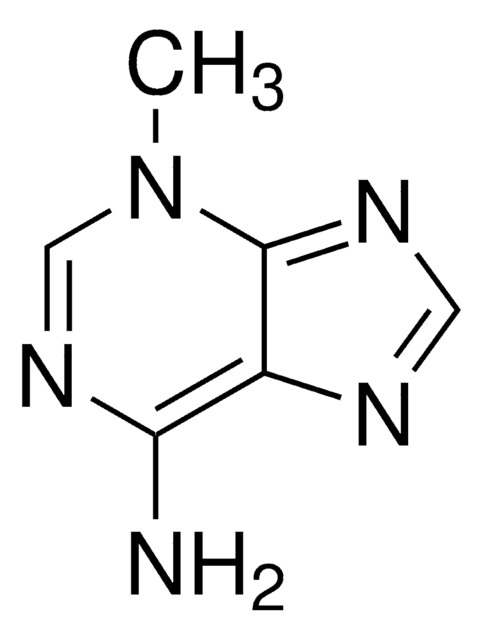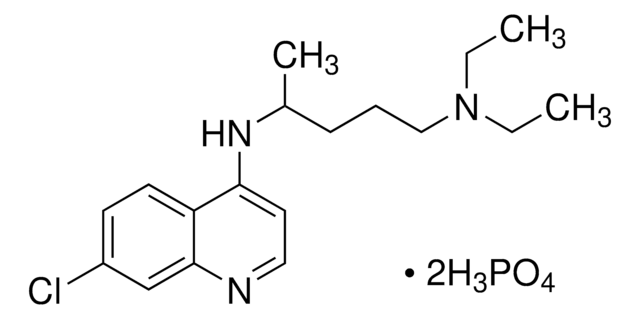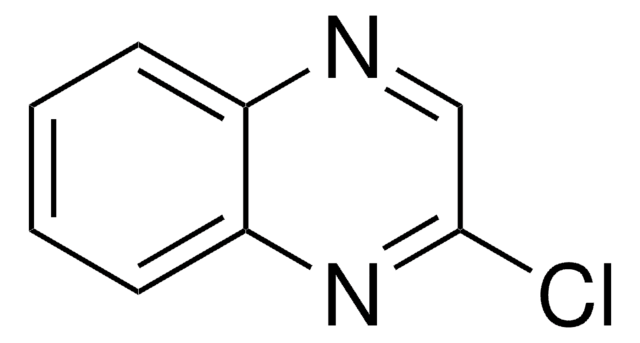C6628
Chloroquine diphosphate salt
98.5-101.0% (EP), powder or crystals, anti-malarial drug
Synonym(s):
N4-(7-chloroquinolin-4-yl)-N1,N1-diethylpentane-1,4-diamine diphosphate, N4-(7-Chloro-4-quinolinyl)-N1,N1-dimethyl-1,4-pentanediamine diphosphate salt
About This Item
Recommended Products
product name
Chloroquine diphosphate salt, powder or crystals, 98.5-101.0% (EP)
Quality Level
assay
98.5-101.0% (EP)
form
powder or crystals
mp
192-198 °C
antibiotic activity spectrum
parasites
mode of action
enzyme | inhibits
SMILES string
OP(O)(O)=O.OP(O)(O)=O.CCN(CC)CCCC(C)Nc1ccnc2cc(Cl)ccc12
InChI
1S/C18H26ClN3.2H3O4P/c1-4-22(5-2)12-6-7-14(3)21-17-10-11-20-18-13-15(19)8-9-16(17)18;2*1-5(2,3)4/h8-11,13-14H,4-7,12H2,1-3H3,(H,20,21);2*(H3,1,2,3,4)
InChI key
QKICWELGRMTQCR-UHFFFAOYSA-N
Gene Information
human ... ABCC1(4363)
Looking for similar products? Visit Product Comparison Guide
Related Categories
General description
Application
Chloroquine diphosphate salt has been used :
- in in vitro antiplasmodial assays
- in transfection and infection assays
- in autophagy inhibition
- in differentiation of induced pluripotent stem (iPS) cells into cardiomyocytes
- in flow treatment of infected blood
Biochem/physiol Actions
Features and Benefits
signalword
Warning
hcodes
Hazard Classifications
Acute Tox. 4 Oral
Storage Class
11 - Combustible Solids
wgk_germany
WGK 3
flash_point_f
Not applicable
flash_point_c
Not applicable
ppe
dust mask type N95 (US), Eyeshields, Gloves
Certificates of Analysis (COA)
Search for Certificates of Analysis (COA) by entering the products Lot/Batch Number. Lot and Batch Numbers can be found on a product’s label following the words ‘Lot’ or ‘Batch’.
Already Own This Product?
Find documentation for the products that you have recently purchased in the Document Library.
Customers Also Viewed
Articles
We presents an article on Autophagy in Cancer Promotes Therapeutic Resistance
Protein-based drug transporters are found in most tissues including liver, kidney, intestine, and brain. These transporters are particularly important in cancer treatment and multi-drug resistance research. Understanding the specific mechanisms of tumor cell transporters is becoming an essential aspect of chemotherapeutic drug design.
Related Content
Discover Bioactive Small Molecules for ADME/Tox
Chromatograms
application for HPLCOur team of scientists has experience in all areas of research including Life Science, Material Science, Chemical Synthesis, Chromatography, Analytical and many others.
Contact Technical Service











